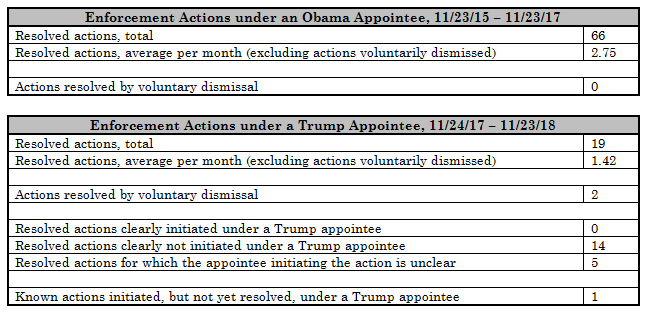Proving that Mick Mulvaney Compromised CFPB Enforcement
By Mark Totten | Michigan State University College of Law
An investigative report in Tuesday’s Washington Post documents the demise of enforcement at the Consumer Financial Protection Bureau (CFPB) under President Trump’s Acting Director, Mick Mulvaney. It concludes: “One year after Mulvaney’s arrival, he and his political aides have constrained the agency from within, achieving what conservatives on Capitol Hill had for years been unable to do.” The report mentions my findings about enforcement actions under Obama and Trump appointees. A quick dive into the data shows Mulvaney has curbed enforcement and, as a result, compromised the agency’s mission.
Method
To provide a point of comparison, I gathered all enforcement actions resolved by the CFPB between November 23, 2015 and November 23, 2018. This time span represents two years of agency enforcement under an Obama appointee, Director Richard Cordray (who left office on November 24, 2017), and one year under a Trump appointee, Acting Director Mick Mulvaney.
Identifying all enforcement actions resolved during this time period was not difficult. The agency posts all actions, whether judicial or administrative, in a special database on its webpage. Moreover, federal law requires the agency to provide a semi-annual list to Congress of all pending enforcement actions. The available reports confirmed the actions listed in the agency’s database.[1]
Numbers
This study revealed a few key data points:
Results
Two qualifications are in order. First, the time span under a Trump appointee for this study was only 12 months. Having a full 24 months of data under a Trump appointee would, of course, be more revealing. Second, this study examines only one aspect of enforcement: the quantity of cases. A full assessment would consider multiple qualities, including the nature of the harms targeted and the relief received. One of the cases the agency resolved under a Trump appointee, for example, was Wells Fargo Bank, N.A. (2018-BCFP-0001), which resulted in a $1 billion civil penalty – the largest civil penalty imposed by the agency to date. (Although Cordray likely initiated the action.)
Keeping these limitations in mind, the data nonetheless reveal a striking drop in the number of enforcement actions since a Trump appointee took control of the CFPB. The average monthly rate of resolved enforcement actions has fallen by nearly half, as compared to the average monthly rate during the last two years under an Obama appointee.
Moreover, the data suggest a clear downward trend that will almost certainly continue to drop over time. In other words, the average monthly enforcement rate under Mulvaney is too cheery. Here’s why. The 12 months studied since Cordray left office marks a transition period that inevitably includes several legacy actions that, while resolved under Mulvaney, were initiated under Cordray. Consider the data more closely. The study reveals 19 cases resolved under a Trump appointee. To much criticism, Mulvaney voluntarily dismissed two of these cases, both initiated under Cordray. See Golden Valley Lending, Inc., D. Kan. 2:17-cv-02521; PHH Corp., 2014-CFPB-0002. Moreover, an Obama appointee initiated 12 of the remaining 17 resolved actions.
What of the remaining 5 actions? The largest of these cases is Wells Fargo Bank, N.A., mentioned earlier with its $1 billion civil penalty. Although the resolving documents are silent, Cordray proclaimed on Twitter that he started this investigation, and a Reuters report said the same. Reuters also reported that two of the other cases, Triton Management Group (2018-BCFP-0005) and Security Group, Inc. (2018-BCFP-0002), also began under Cordray. And neither the face of the resolving documents nor media reports indicate whether Cordray or Mulvaney launched the final two cases, Bluestem Brands (2018-BCFP-0006) and Santander Bank, N.A. (2018-BCFP-0008).
What do we know about actions initiated under a Trump appointee but not yet resolved? The record only reveals a single pending case, Future Income Payments, LLC (D.D. Cal. 8:18-cv-01654), which the agency filed on September 13, 2018. Of course, the record generally reveals only pending judicial actions, which require the filing of a complaint; the agency typically announces administrative actions only on the date they resolve. Mulvaney may have launched multiple administrative actions since taking office, but which are not yet available in the public record. The steep drop in resolved enforcement actions since a Trump appointee took office, however, suggests the agency is not keeping pace with its past performance.
Keeping the limitations of this study in mind, the conclusion is nonetheless striking: a precipitous drop in the rate of enforcement at the CFPB since President Trump took control, with the likelihood this rate will continue to fall. These numbers, coupled with the well-sourced reporting in the WaPo report, show an orchestrated effort to undermine the agency from within.
[1] To draw meaningful comparisons, I adopted a few rules on counting cases. For example, I focused only on resolved actions, as opposed to initiated or pending cases. Unlike a judicial action that has a clear initiation date when the agency files a complaint, most administrative actions settle and are only announced to the public the day of settlement. The resolving date is the date a resolving document issues, regardless of appeal. I also adopted a rule regarding related actions. Sometimes the agency files a single action against multiple defendants, while other times it files separate actions against defendants involved in a common scheme. I deemed separate actions to be related – and therefore counted only once for purposes of this study – if, on the face of the initiating and/or resolving documents, they manifested a common scheme and one or more common defendants.
Tags:
Regulation Administrative Law Consumer Protection

